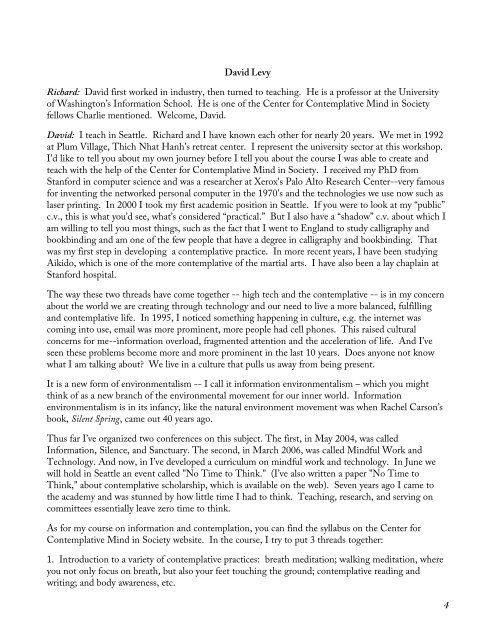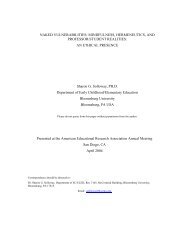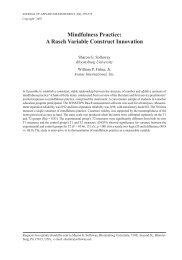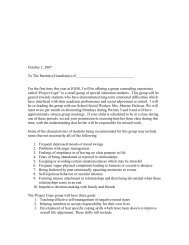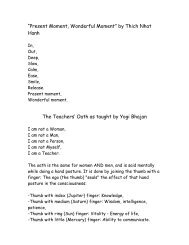Morning Introduction & Plenary Session (.pdf) - The Mindfulness in ...
Morning Introduction & Plenary Session (.pdf) - The Mindfulness in ...
Morning Introduction & Plenary Session (.pdf) - The Mindfulness in ...
You also want an ePaper? Increase the reach of your titles
YUMPU automatically turns print PDFs into web optimized ePapers that Google loves.
David Levy<br />
Richard: David first worked <strong>in</strong> <strong>in</strong>dustry, then turned to teach<strong>in</strong>g. He is a professor at the University<br />
of Wash<strong>in</strong>gton’s Information School. He is one of the Center for Contemplative M<strong>in</strong>d <strong>in</strong> Society<br />
fellows Charlie mentioned. Welcome, David.<br />
David: I teach <strong>in</strong> Seattle. Richard and I have known each other for nearly 20 years. We met <strong>in</strong> 1992<br />
at Plum Village, Thich Nhat Hanh's retreat center. I represent the university sector at this workshop.<br />
I'd like to tell you about my own journey before I tell you about the course I was able to create and<br />
teach with the help of the Center for Contemplative M<strong>in</strong>d <strong>in</strong> Society. I received my PhD from<br />
Stanford <strong>in</strong> computer science and was a researcher at Xerox's Palo Alto Research Center--very famous<br />
for <strong>in</strong>vent<strong>in</strong>g the networked personal computer <strong>in</strong> the 1970's and the technologies we use now such as<br />
laser pr<strong>in</strong>t<strong>in</strong>g. In 2000 I took my first academic position <strong>in</strong> Seattle. If you were to look at my “public”<br />
c.v., this is what you’d see, what’s considered “practical.” But I also have a “shadow” c.v. about which I<br />
am will<strong>in</strong>g to tell you most th<strong>in</strong>gs, such as the fact that I went to England to study calligraphy and<br />
bookb<strong>in</strong>d<strong>in</strong>g and am one of the few people that have a degree <strong>in</strong> calligraphy and bookb<strong>in</strong>d<strong>in</strong>g. That<br />
was my first step <strong>in</strong> develop<strong>in</strong>g a contemplative practice. In more recent years, I have been study<strong>in</strong>g<br />
Aikido, which is one of the more contemplative of the martial arts. I have also been a lay chapla<strong>in</strong> at<br />
Stanford hospital.<br />
<strong>The</strong> way these two threads have come together -- high tech and the contemplative -- is <strong>in</strong> my concern<br />
about the world we are creat<strong>in</strong>g through technology and our need to live a more balanced, fulfill<strong>in</strong>g<br />
and contemplative life. In 1995, I noticed someth<strong>in</strong>g happen<strong>in</strong>g <strong>in</strong> culture, e.g. the <strong>in</strong>ternet was<br />
com<strong>in</strong>g <strong>in</strong>to use, email was more prom<strong>in</strong>ent, more people had cell phones. This raised cultural<br />
concerns for me--<strong>in</strong>formation overload, fragmented attention and the acceleration of life. And I’ve<br />
seen these problems become more and more prom<strong>in</strong>ent <strong>in</strong> the last 10 years. Does anyone not know<br />
what I am talk<strong>in</strong>g about? We live <strong>in</strong> a culture that pulls us away from be<strong>in</strong>g present.<br />
It is a new form of environmentalism -- I call it <strong>in</strong>formation environmentalism – which you might<br />
th<strong>in</strong>k of as a new branch of the environmental movement for our <strong>in</strong>ner world. Information<br />
environmentalism is <strong>in</strong> its <strong>in</strong>fancy, like the natural environment movement was when Rachel Carson’s<br />
book, Silent Spr<strong>in</strong>g, came out 40 years ago.<br />
Thus far I’ve organized two conferences on this subject. <strong>The</strong> first, <strong>in</strong> May 2004, was called<br />
Information, Silence, and Sanctuary. <strong>The</strong> second, <strong>in</strong> March 2006, was called M<strong>in</strong>dful Work and<br />
Technology. And now, <strong>in</strong> I’ve developed a curriculum on m<strong>in</strong>dful work and technology. In June we<br />
will hold <strong>in</strong> Seattle an event called "No Time to Th<strong>in</strong>k." (I’ve also written a paper "No Time to<br />
Th<strong>in</strong>k," about contemplative scholarship, which is available on the web). Seven years ago I came to<br />
the academy and was stunned by how little time I had to th<strong>in</strong>k. Teach<strong>in</strong>g, research, and serv<strong>in</strong>g on<br />
committees essentially leave zero time to th<strong>in</strong>k.<br />
As for my course on <strong>in</strong>formation and contemplation, you can f<strong>in</strong>d the syllabus on the Center for<br />
Contemplative M<strong>in</strong>d <strong>in</strong> Society website. In the course, I try to put 3 threads together:<br />
1. <strong>Introduction</strong> to a variety of contemplative practices: breath meditation; walk<strong>in</strong>g meditation, where<br />
you not only focus on breath, but also your feet touch<strong>in</strong>g the ground; contemplative read<strong>in</strong>g and<br />
writ<strong>in</strong>g; and body awareness, etc.<br />
4


